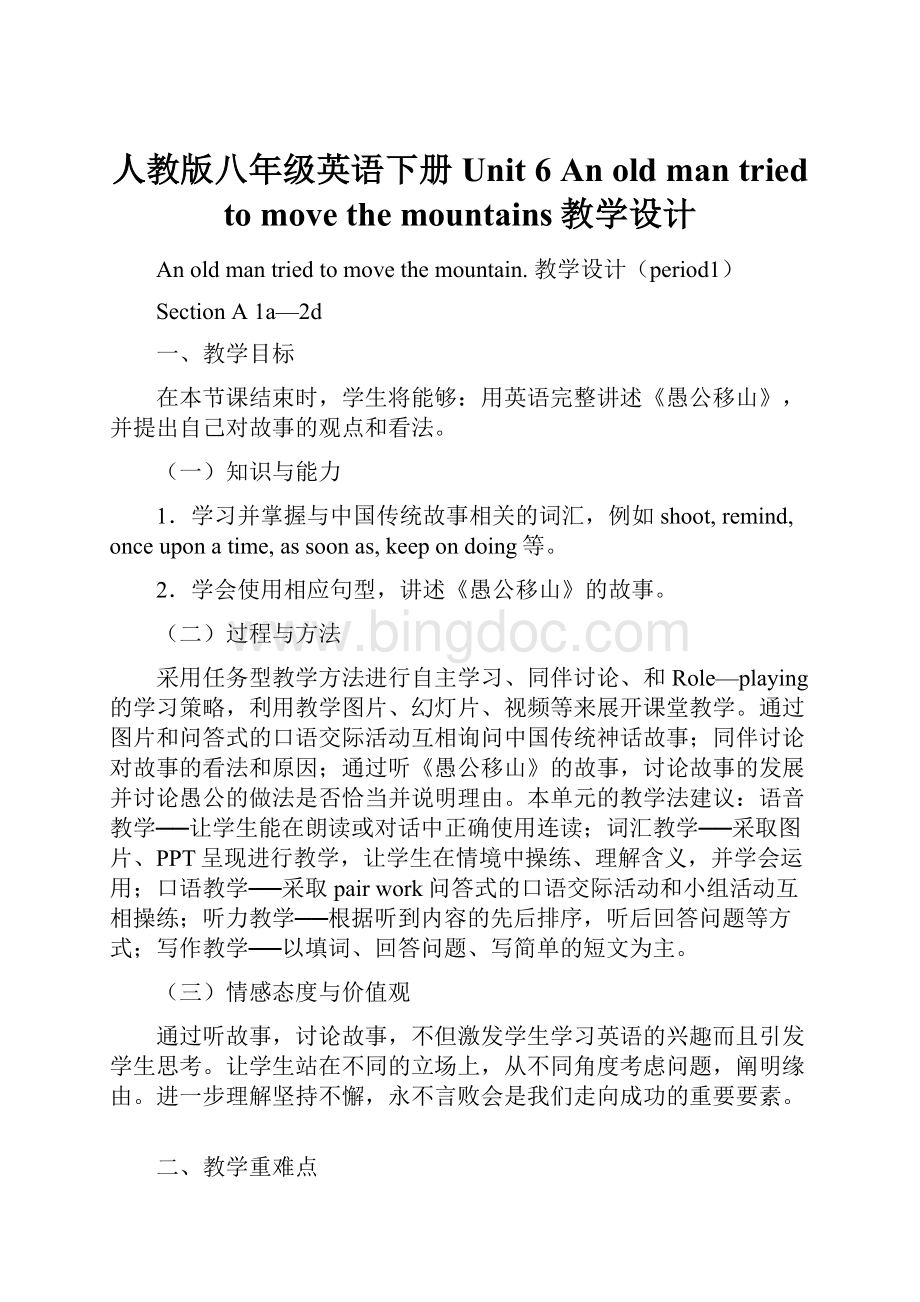人教版八年级英语下册Unit 6 An old man tried to move the mountains教学设计.docx
《人教版八年级英语下册Unit 6 An old man tried to move the mountains教学设计.docx》由会员分享,可在线阅读,更多相关《人教版八年级英语下册Unit 6 An old man tried to move the mountains教学设计.docx(14页珍藏版)》请在冰点文库上搜索。

人教版八年级英语下册Unit6Anoldmantriedtomovethemountains教学设计
Anoldmantriedtomovethemountain.教学设计(period1)
SectionA1a—2d
一、教学目标
在本节课结束时,学生将能够:
用英语完整讲述《愚公移山》,并提出自己对故事的观点和看法。
(一)知识与能力
1.学习并掌握与中国传统故事相关的词汇,例如shoot,remind,onceuponatime,assoonas,keepondoing等。
2.学会使用相应句型,讲述《愚公移山》的故事。
(二)过程与方法
采用任务型教学方法进行自主学习、同伴讨论、和Role—playing的学习策略,利用教学图片、幻灯片、视频等来展开课堂教学。
通过图片和问答式的口语交际活动互相询问中国传统神话故事;同伴讨论对故事的看法和原因;通过听《愚公移山》的故事,讨论故事的发展并讨论愚公的做法是否恰当并说明理由。
本单元的教学法建议:
语音教学──让学生能在朗读或对话中正确使用连读;词汇教学──采取图片、PPT呈现进行教学,让学生在情境中操练、理解含义,并学会运用;口语教学──采取pairwork问答式的口语交际活动和小组活动互相操练;听力教学──根据听到内容的先后排序,听后回答问题等方式;写作教学──以填词、回答问题、写简单的短文为主。
(三)情感态度与价值观
通过听故事,讨论故事,不但激发学生学习英语的兴趣而且引发学生思考。
让学生站在不同的立场上,从不同角度考虑问题,阐明缘由。
进一步理解坚持不懈,永不言败会是我们走向成功的重要要素。
二、教学重难点
(一)教学重点
1.学习用英语讲述故事的要素。
2.学会表达对事情的看法,并阐明缘由。
3.训练在听力过程中提取关键信息的能力。
(二)教学难点
1.学会表达对事情的看法,并阐明缘由。
2.训练在听力过程中提取关键信息的能力。
三、教学策略
语音教学──让学生能在朗读或对话中正确使用连读;词汇教学──采取图片,PPT呈现环节进行教学,让学生在情境中操练、理解含义,并学会运用;口语教学──采取pairwork问答式的口语交际活动和小组活动互相操练;听力教学──根据听到内容的先后排序,听后回答问题等方式;写作教学──以填词、回答问题、写简单的短文为主。
四、教学过程
Step1:
Lead-in
首先让学生说说所知道的中国传统神话故事,让学生以pairwork的形式讨论并用英文表达这些故事。
老师可以加入学生的讨论,并给予一定的建议和指导。
【设计意图】
通过让学生回顾中国传统的神话故事并尝试翻译这些故事的名称,使学生初步了解本节课的内容,激发他们用英语讲述中国传统故事的学习兴趣和热情。
Step2:
Presentation
Activity1.利用图片逐步呈现经典的中国传统故事,学生讨论其英语翻译,然后教师呈现其英文表达。
【设计意图】
了解一些故事名称的英语表达方式,为他们用英语表达中国故事奠定基础。
Activity2.完成书上任务:
1a匹配故事标题和图片
【设计意图】
通过呈现故事的图片,让学生完成1a的任务。
同时让学生更多地了解一些中国传统故事的英文表达法。
Step3:
回顾《愚公移山》中的主要人物
Whoarethemaincharactersinthestory?
【设计意图】
回忆故事,使学生对即将完成的听力任务做好准备。
Step4:
Listeningtask1
Activity1.Pre-listening.通过以图片的形式呈现听力任务中出现的生词dig,earthandstone这两个关键表达,扫清学生的听力障碍。
【设计意图】
运用多媒体的直观性,使学生轻松地理解、掌握新知识,符合学生的认知,达到呈现的目的,增强教学的实效性。
Activity2.听力材料以对话的形式呈现了《愚公移山》故事的英文版。
通过听力练习,学生完成1b的两个听力任务。
【设计意图】
训练学生理解所听语段的主旨要义;训练学生获取事实性具体信息。
Activity3:
Post-listeningDiscussing学生回答有关故事的相关问题,用自己的语言再次呈现故事的背景、起因和发展。
【设计意图】
训练学生运用相应的语法,恰当的词汇和句式完成口头回答问题的任务。
Step5:
Listeningtask2
Activity1.继续听故事的发展和结局,根据故事发展的先后顺序对图片进行排序。
【设计意图】
训练学生获取具体信息,并根据信息进行简单推断。
Activity2.继续听故事的发展和结局,获取关键信息并填空。
【设计意图】
训练学生获取具体信息,针对所听语段的内容记录简单信息,并理解说话者的观点和态度。
Step6:
Tellingthestory
Activity1:
通过pairwork故事接龙的形式,继续讲述故事的发展,经过和结果。
A:
YuGongandhisfamilybegantomovesomeoftheearthandstonetothesea.
B:
Oneday,amansawYuGongandhischildrenwhentheywereworkingonmovingthemountains.
A:
HetoldYuGongthathecouldneverdoitbecausehewasoldandweak.
B:
Assoonasthemanfinishedtalking,YuGongsaidthathisfamilycouldcontinuetomovethemountainsafterhedied.
…
【设计意图】
让学生继续讲述故事,训练他们能在表达上做到内容完整,意思连贯,条理清楚。
Step7:
Listening
Activity1:
听2a对话并排序。
Activity2:
听2b对话并根据对话内容填空。
【设计意图】
通过2a-2b的听力对话对电视节目的讨论更加深入,主人公在表达自己观点时陈述了喜欢某种电视节目的原因,其中还呈现了不定式作宾语的更多实例,如:
expecttodo,liketodo,trytodo,plantodo等。
Step8:
Discussing
Activity:
根据听力材料的内容,讨论以下问题:
1.WhatdoyouthinkofYuGong?
Use3adjectivestodescribehim.
2.DoyouthinkitisagoodwayforYuGongtosolvetheproblembymovingthemountains?
3.Whatcouldhedoinsteadofmovingamountain?
【设计意图】
让学生继续谈论听力内容,并提出自己的看法。
训练学生尝试使用所学语言表达自己的真实想法,逐步从模仿语言过渡到运用语言。
Step9:
2dRole-playtheconversation
Activity1:
角色扮演。
Activity2:
学生根据对话,提炼不同人的观点和态度,完成表格。
【设计意图】
让学生获取发表态度和观点的信息,体会所学语言在真实语境中的使用情况,并为学生模仿语言和进一步拓展该话题提供了示范。
Step10:
Homework
Writeaboutthestory:
YuGongmovesthemountain.
Requirements:
Part1:
whatisthestoryabout?
Part2:
whatdoyouthinkofthestory?
Why?
【设计意图】
笔头巩固所学的故事,并提出自己的观点、阐述理由。
sectionA3a-3c教学设计
1教学目标
1.KnowledgeObject:
1)KeyVocabulary:
object,magic,stick,hide,tail,turn…into,excite,western,stepsister,prince,couple,smile,marry,getmarried,fit,fallinlove
2)TargetLanguage:
TheMonkeyisthemaincharacterinthetraditionalChinesebookJourneytotheWest.
AndassoonastheTVprogramcameoutmorethan30yearsago,Westernchildrenbecameinterestedinreadingthisstory.
2学情分析
Beabletounderstandthepassageandlearntotellastoryusingthetargetlanguage.
Enablestudentstopracticereadingandwritingwiththetargetlanguage.
Learntheusageof“unless”,“assoonas”and“so…that”.
3.Moral Objects:
Educatestudentstokeepfightingagainstevildoersandbaddeedsandnevergiveup
3重点难点
KeyVocabulary:
object,magic,stick,hide,tail,turn…into,excite,western
TargetLanguage:
TheMonkeyisthemaincharacterinthetraditionalChinesebookJourneytotheWest.
AndassoonastheTVprogramcameoutmorethan30yearsago,Westernchildrenbecameinterestedinreadingthisstory.
Beabletounderstandthefairystoryandtelltheirfavoritestorywithtargetlanguage.
4教学过程
教学活动
活动1【导入】 Warming up
…LetsomeSstellthestoryofYuGongmovesamountain.
活动2【讲授】 New words
。
1. Lookatthepicturesandlearnaboutthenewwords.
object,magic,stick,hide,tail,turn…into,excite,western,stepsister,prince,couple,smile,marry,getmarried,fit,fallinlove
2.Askstudentstopracticemakingsentenceswiththem.
活动3【讲授】Reading
Work on 3a:
1. Look at the pictures and answer the questions.
1). Who are they?
2). In which book are they the main characters?
3). Which character do you like best?
Keys:
1. They’re Zhu Bajie, Su Wukong, Sha Heshang and Tang Seng.
2. Journey to the West.
3. I like Monkey King best.
2. Watch a video about the Monkey King.
3. Tell Ss to read the article in 3a quickly and try to find the answers to the questions:
① Which book is talked about?
② Who is the main character?
③ What is he like?
4.Ss read the article quickly and try to answer the questions:
Keys:
1. Journey to the West.
2. The Monkey King.
3. He is not just any normal monkey. In fact, he sometimes does not even look like a monkey!
Work on 3b:
1. Have student read the chart in 3b, and then read the passage again and complete the content about the Monkey King
What he can do:
① He can make 72 changes to his shape and size, turning himself into different animals and objects
② He can make his magic stick small or large.
What he can’t do:
Unless he can hide his tail, he can’t turn himself into a person.
2. Check the answers.
Work on 3c
1.Have students complete the sentences in 3c.
5. Check the answers。
Keys:
1. traditional 2. came out, became interested in 3. make 72 changes, turn himself into 4. is able to
活动4【导入】presentation
1.…turninghimselfintodifferentanimalsandobjects.
turn…into… 变成 e.g.IhaveadreamthatI'veturnedintoanelephant.
2.Butunlesshecanhidehistail,hecannotturnhimselfintoaperson.
unless conj.如果不;除非。
引导条件状语从句,=if…not。
e.g.UnlessIdo,we’llbelost.
hide v.隐藏;隐蔽。
(hide-hid-hidden)e.g.Wheredidyouhidethemoney?
3.…theMonkeyKingusesamagicstick.
magic adj.有魔力的;有神奇力量的e.g.Allthepeopleheardofthemagiccarpet.
Step5 GrammarFocus
1.Askstudentsthequestionsinleftcolumnandcallsomestudentsanswerthem.
2.Letthemreadandrememberthesentencesofthegrammarfocusbythemselves.
Explain:
unless是连词,意为“除非;如果不”,引导条件状语从句,含有否定意义,相
当于if...not。
注意:
unless引导条件状语从句时,如果主句是一般将来时,从句用一般现在时
表将来。
如:
We’llgototheconcertunlessitdoesn’train.
assoonas是连词词组,引导时间状语从句,意为“一……就……”。
assoonas引导的时间状语从句中,若主句是一般将来时,从句用一般现在时表将来。
如:
Mybrotherwilllookforajobassoonasheleavesschool.
so...that表示“如此……以至于……”,常用于引导结果状语从句。
常见结构为:
“so+形容词/副词+that从句”或“so+形容词+a/an+单数名词+that从句”。
3.Havestudentspracticemakinguptheirownsentenceswithconjunctionssuchasunless,assoonas,andso…that.
活动5【讲授】summary
Thisclass,wehavelearntsomenewwordsandsomesentences.Andwehavealsoreadthepassageanddonesomeexercises.Weshouldkeepfightingagainstevildoersandbaddeedsandnevergiveup
活动6【练习】Homework
Havestudentswriteastoryandtellthestorytotheirpartners.
SectionB1a-1d教学设计
1教学目标
Knowledge aims:
1.Get the students to learn the words and phrases:
gold, emperor, silk, underwear, nobody, stupid, cheat
2.The students will be able to use the sentence structure:
Once upon a time, there was…/so…that…/as soon as/unless/but/so/finally
3. Learn to tell a story in English.
Ability aims:
1、To train students’ listening and speaking skills
2、Listening to get the general idea and the detailed information.
3. Speaking to practice oral English.
Emotional aims:
Remember to dare to say the truth. We should be honest
2学情分析
The topic is about Chinese legends and stories. And the fourth period is mainly about a fairy story---The emperor’s new clothes. There are 4 new words in 1a, it make preparations for the story. Then 1b tells the of the story. 1c gets Ss to master the key information of the story. Finally, after learning the story, students can tell the story with their own words.
3重点难点
Teaching important points:
Use the new words and expressions correctly
2、How to tell the story.
Teaching difficult points:
It may be difficult for the students to tell the story in English.
Discussing the characters is also difficult.
4教学过程
教学活动
活动1【讲授】unit 6 SectionB 1a-1d
Step1、
Revisions
Revise the story the journey to the west by asking some questions about it.
Students answer and revise the story.
Help the students to revise the story and make preparations.
Step 2、Watch a video
Play a short video about the story of the emperor’s new clothes.
Students watch and answer three questions.
Help the students to get a very vivid image of the story.
Step 3 Presentation
Show some pictures on the screen and present the new words.
Students watch and learn the new words.
Help the students to learn the story and get ready for the task below.
Step 4 1a
Get the students to match the words with the pictures and check the answers.
Students match the new words and the pictures.
Help the students to master the new words.
Step 5
Listening1b, 1c
Listen and number the pictures.
Listen and fill